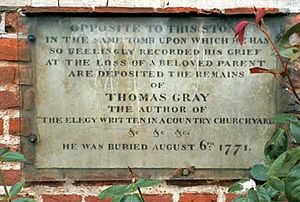Thomas Gray facts for kids
Quick facts for kids
Thomas Gray
|
|
|---|---|
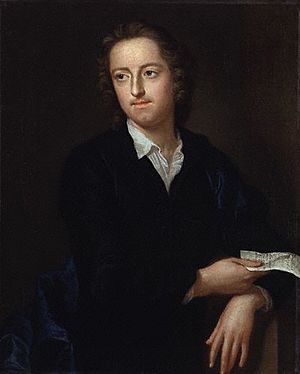
Portrait by John Giles Eccardt, 1747–1748
|
|
| Born | 26 December 1716 Cornhill, London, England |
| Died | 30 July 1771 (aged 54) Cambridge, England |
| Occupation | Poet, historian |
| Alma mater | Peterhouse, Cambridge Eton College |
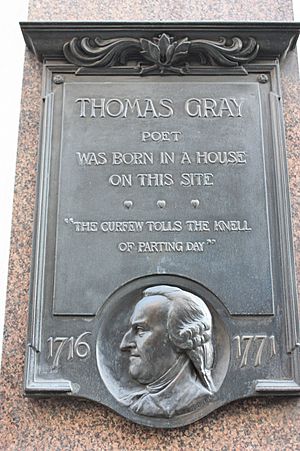
Thomas Gray (born December 26, 1716 – died July 30, 1771) was an English poet and scholar. He was also a professor at Pembroke College in Cambridge. He is best known for his famous poem, Elegy Written in a Country Churchyard, which came out in 1751.
Gray was very hard on himself about his writing. He only published 13 poems during his lifetime, even though many people liked his work. He was even offered the important job of Poet Laureate (the official poet for the King or Queen) in 1757, but he said no. His poems are often seen as "pre-Romantic." This means they showed ideas that later became popular in the Romantic movement in literature.
Contents
Growing Up and School
Thomas Gray was born in Cornhill, London. His father, Philip Gray, was a scrivener (someone who copied documents). His mother, Dorothy Antrobus, was a milliner (someone who made hats). Thomas was the only one of his twelve brothers and sisters to live past infancy. He lived with his mother after she left his father.
Gray's mother paid for him to go to Eton College. His uncles, Robert and William Antrobus, worked there. Robert was Gray's first teacher and helped him love botany (the study of plants) and science. Gray's other uncle, William, was his tutor. Gray remembered his school days as very happy. He wrote about this in his poem "Ode on a Distant Prospect of Eton College".
Gray was a quiet and studious boy. He spent his time reading and avoided sports. He made three close friends at Eton: Horace Walpole, Thomas Ashton, and Richard West. They called themselves the "quadruple alliance" because they were so close. They were proud of their style, humor, and love for beauty.
In 1734, Gray went to Peterhouse, Cambridge university. He found the lessons boring. He wrote letters to his friends complaining about the teachers. He was supposed to study law, but he spent most of his time reading old and new books. He also played music on the harpsichord. Gray later moved to Pembroke College. This happened after some students played a joke on him. Gray was afraid of fire. He had a rope outside his window to escape. One night, students lit a small fire near his window. Gray climbed down the rope but landed in a tub of water they had placed there!
In 1738, Gray traveled around Europe with his friend Horace Walpole. This trip was called the Grand Tour. They had a disagreement in Tuscany and went their separate ways. Walpole liked going to parties, while Gray wanted to see old historical sites. They became friends again a few years later. Walpole later helped Gray publish his poems.
Writing and Teaching
Gray started writing poems seriously in 1742. This was after his close friend Richard West died, which inspired his poem "Sonnet on the Death of Richard West." He moved to Cambridge and studied literature on his own. He became one of the most knowledgeable people of his time. He became a Fellow (a senior member) first at Peterhouse and then at Pembroke College, Cambridge.
Gray spent most of his life as a scholar in Cambridge. He only started traveling again later in life. He did not write many poems. His total published works during his lifetime were less than 1,000 lines. Still, he is seen as the most important English poet of the mid-1700s. In 1757, he was offered the job of Poet Laureate, but he turned it down. Gray was so critical of his own work and afraid of failing that he published only thirteen poems. He once joked that his collected works might be "mistaken for the works of a flea."
Gray became known as one of the "Graveyard poets" of the late 18th century. These poets, like Oliver Goldsmith and William Cowper, wrote about death and what happens after life.
In 1768, Gray became the Regius Professor of Modern History at Cambridge. This was a teaching position with a good salary.
Famous Poems
- Ode on the Spring (written in 1742)
- On the Death of Richard West (written in 1742)
- Ode on the Death of a Favourite Cat, Drowned in a Tub of Goldfishes (written in 1747)
- Ode to a Distant Prospect of Eton College (written in 1747)
- Elegy Written in a Country Churchyard (written between 1745 and 1750)
- The Progress of Poesy: A Pindaric Ode (written between 1751 and 1754)
- The Bard: A Pindaric Ode (written between 1755 and 1757)
- The Fatal Sisters: An Ode (written in 1761)
The "Elegy" Masterpiece
Many people believe Gray started writing his most famous poem, Elegy Written in a Country Churchyard, in the churchyard of St Giles' church in Stoke Poges, Buckinghamshire. He started it in 1742 but finished it in 1750. The poem became a huge hit when it was published in 1751. People loved its calm and thoughtful style. It was copied, imitated, quoted, and even translated into Latin and Greek. It is still one of the most popular and quoted poems in English.
In 1759, during a war, a British general named James Wolfe supposedly recited the poem to an officer. He said he would rather have written that poem than win the battle the next day.
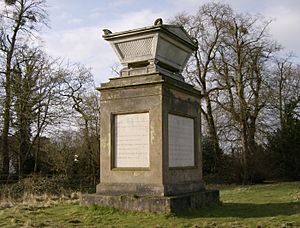
The Elegy was instantly recognized for its beauty and skill. It contains many phrases that are still used today. These include:
- "The Paths of Glory" (used as a movie title)
- "Celestial fire"
- "Some mute inglorious Milton"
- "Far from the Madding Crowd" (used as a novel title by Thomas Hardy)
- "Full many a flower is born to blush unseen, and waste its sweetness on the desert air"
- "The unlettered muse"
- "Kindred spirit"
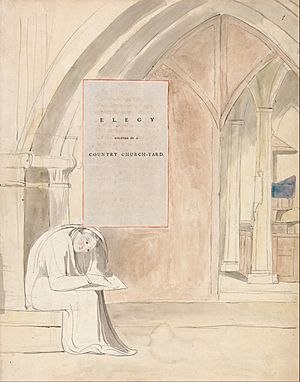
The "Elegy" explores ideas about death and the afterlife. These ideas hinted at the "Gothic movement" in literature that came later. It is thought that Gray might have been inspired by visiting his aunt Mary Antrobus's grave. She was buried in the St. Giles' churchyard, which he and his mother often visited. Gray himself was later buried in the same place.
Gray also wrote funny poems. One example is Ode on the Death of a Favourite Cat, Drowned in a Tub of Gold Fishes. This poem is a mock elegy (a poem that makes fun of a serious elegy) about Horace Walpole's cat, Selima. The poem starts by asking, "What female heart can gold despise? What cat's averse to fish?" It then ends with famous sayings like "a fav'rite has no friend" and "nor all that glisters, gold."
Gray's letters also show his sharp observations and playful humor. He is known for the phrase, "where ignorance is bliss, 'tis folly to be wise." This line is from his poem Ode on a Distant Prospect of Eton College.
Poetic Styles
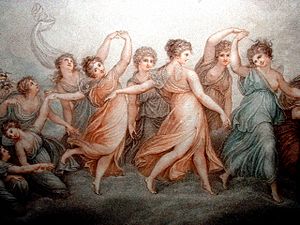
Gray thought his best works were his two Pindaric odes: The Progress of Poesy and The Bard. Pindaric odes are meant to be full of fire and passion. This is different from calmer odes like Ode on a Distant Prospect of Eton College. The Bard tells the story of a Welsh poet who curses the English king Edward I. The poet predicts the downfall of the king's family. The poem ends with the poet jumping to his death from a mountain.
When he had time, Gray traveled around Britain. He visited places like Yorkshire, Scotland, and the Lake District. He was looking for beautiful landscapes and old monuments. These natural and ancient sights were not very popular in the early 1700s. Most people preferred neat, classical styles. The "Gothic" details in his Elegy and The Bard were an early sign of the Romantic movement. This movement became very popular in the early 1800s. Poets like William Wordsworth taught people to value wild, beautiful, and mysterious places. Gray mixed old poetic forms with new ideas. He can be seen as a classical poet who helped lead the way to the Romantic style.
Death
Thomas Gray died on July 30, 1771, in Cambridge. He was buried next to his mother in the churchyard of the Church of St Giles, Stoke Poges. This is the same churchyard that is believed to be the setting for his famous Elegy. You can still visit his grave there today.
Honors
- Gray's friend and biographer, William Mason, put up a monument to him. It is in Poets' Corner at Westminster Abbey and was built in 1778.
- John Penn had a memorial built for Gray near St Giles' churchyard. It has parts of the "Elegy" carved into it.
- A plaque in Cornhill, London, marks the place where he was born.
See also
 In Spanish: Thomas Gray para niños
In Spanish: Thomas Gray para niños


